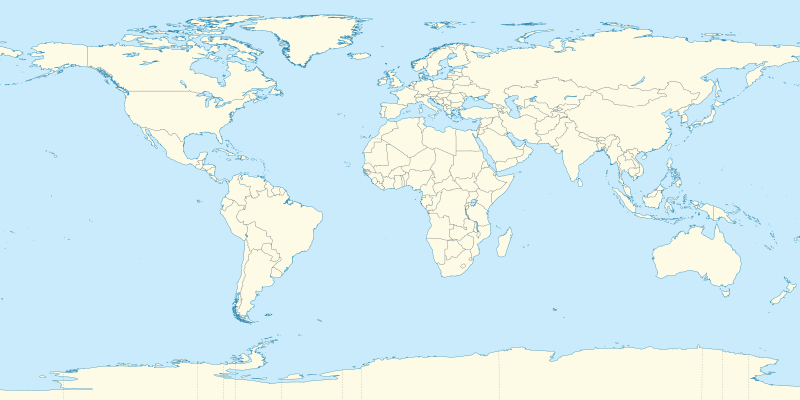GSAT
GSAT is a series of Indian communications , research and technology satellites from ISRO .
(Called GSAT-1, also GramSat 1) The first satellite was supported by a on 18 April 2001 GSLV - carrier rocket into a geostationary brought orbit. It was used for attempts to transmit digital information (audio signals, Internet, digital television). The satellites are based on India's I-2000 (I-2K) and I-3000 (I-3K) satellite buses. Some satellites belong to the Insat range .
List of satellites
| Surname | begin | Launcher | Launch site | orbit | Satellite bus | Remarks |
|---|---|---|---|---|---|---|
| GSAT-1 | April 18, 2001 | GSLV | SHAR | GEO 48 ° East | I-2K |
Failure The rocket did not reach the planned orbit. |
| GSAT-2 | May 8, 2003 | GSLV | SHAR | GEO | I-2K | success |
| GSAT-3 (EDUSAT) | September 20, 2004 | GSLV | SHAR | GEO 74 ° East | I-2K | success |
| GSAT-4 | April 15, 2010 10:57 am |
GSLV | SHAR | - | I-2K | Failure |
| GSAT-5P | December 25, 2010 | GSLV | SHAR | GEO | I-2K |
Failure |
| GSAT-6 (INSAT 4E) | August 27, 2015 | GSLV | SHAR | GEO 83 ° East | I-2K | success |
| GSAT-6A | March 29, 2018 11:26 am |
GSLV | SHAR | GEO | I-2K |
Success Five days after the launch, contact with the satellite was lost. |
| GSAT-7 (INSAT 4F) | August 29, 2013 8:30 p.m. |
Ariane 5 ECA | CSG | GEO 74 ° East | I-2K | success |
| GSAT-7A | 19th December 2018 | GSLV Mk II | SHAR | I-2K | ||
| GSAT-8 (INSAT 4G) | May 20, 2011 8:38 PM |
Ariane 5 ECA | CSG | GEO 55 ° East | I-3K | success |
| GSAT-9 | 5th May 2017 | GSLV | SHAR | in orbit | ||
| GSAT-10 | September 28, 2012 9:18 pm |
Ariane 5 ECA | CSG | GEO 83 ° East | I-3K | success |
| GSAT-11 | December 4, 2018 8:37 PM |
Ariane 5 ECA | CSG | GEO 74 ° East | I-6K | success |
| GSAT-12 | July 15, 2011 11:18 am |
PSLV-XL | SHAR | GEO 83 ° East | I-1K | success |
| GSAT-14 | 5th January 2014 | GSLV | SHAR | GEO 74 ° East | I-2K | success |
| GSAT-15 | November 10, 2015 9:34 PM |
Ariane 5 ECA | CSG | GEO 93.5 ° East | I-3K | success |
| GSAT-16 | December 6, 2014 | Ariane 5 ECA | CSG | GEO 55 ° East | I-3K | success |
| GSAT-17 | June 28, 2017 | Ariane 5 ECA | CSG | I-3K | success | |
| GSAT-18 | 5th October 2016 | Ariane 5 ECA | CSG | GEO 74 ° East | I-3K | success |
| GSAT-19 | 5th June 2017 | GSLV | SHAR | I-3K | ||
| GSAT-29 | November 14, 2018 | GSLV Mk III | SHAR | I-3K | success | |
| GSAT-30 | January 16, 2020 | Ariane 5 ECA | CSG | success | ||
| GSAT-31 | 5th February 2019 | Ariane 5 ECA | CSG | GEO 48 ° East | I-2K | success |
Comments on the individual satellites
- GSAT-1: The satellite did not quite reach the intended position as the Russian 12KRB upper stage only burned 698 seconds instead of the planned 710 seconds. The satellite used a large part of its own fuel to reach them. As payload 1540 kg satellite wore three C-Band - (two with 50 watts and a 10 watt output) and two S-band - Transponder with 70 watts of power. The intended service life was three years.
- GSAT-2: As a payload of 1825 kg satellite, which weighs four C-band and two wore Ku band - transponder . The satellite also carried scientific experiments, including sensors for measuring solar X-rays .
- GSAT-3: The 1950 kg satellite carried six C-band and six Ku-band transponders (with a 1.2 m multibeam antenna) as its payload. The intended service life was seven years.
- GSAT-7: Military communications satellite with C, S, Ku and UHF band transponders
- GSAT-8: 18 Ku-band transponders, 2 BSS transponders, GAGAN system
- GSAT-12: 12 C-band transponders
Positions
Orbital positions of the GSAT satellites |
Web links
- GSat in the Encyclopedia Astronautica (English)
Individual evidence
- ↑ Thomas Weyrauch: GSLV-D3 fails. raumfahrer.net, April 15, 2010, accessed April 15, 2010 .
- ↑ Stephen Clark: ISRO loses contact with new communications satellite , Spaceflight Now, April 3, 2018
- ↑ raumfahrer.net: Ariane 5 launch with two communication satellites
- ↑ India's GSat 1 Stranded Short of Geosynchronous [sic] Orbit (Space and Tech) ( Memento from September 7, 2008 in the Internet Archive )
- ↑ GSAT-1 (tbs satellite)
- ↑ a b c Gunter Krebs: GSat 1. In: Gunter's Space Page. November 3, 2010, accessed April 1, 2011 .
- ↑ India's GSAT-1 Fell Short of GEO (Spacedaily)
- ↑ TS Subramanian: ISRO plans to launch satellite for Navy in a few months. The Hindu, June 6, 2012, accessed September 7, 2012 .
- ↑ Gunter Krebs: GSat 8, 15 (Insat 4G). In: Gunter's Space Page. June 22, 2012, accessed September 10, 2012 .
- ↑ Gunter Krebs: GSat 12. In: Gunter's Space Page. July 15, 2011, accessed July 15, 2011 .
